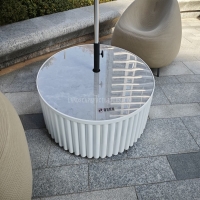Welcome to the website for landscape facilities products and knowledge.
How does the table’s design address ergonomic comfort for users during prolonged use?
In today's demanding work environments, table design has evolved beyond mere functionality to actively address ergonomic comfort during prolonged use. The fundamental principle driving this transformation is human-centered design, which places user well-being at the forefront of furniture engineering.
Modern tables incorporate scientifically calibrated height adjustment mechanisms that accommodate various body types and preferred working postures. These systems, whether manual cranks or electronic controls, allow seamless transitions between sitting and standing positions—a crucial feature proven to reduce spinal compression and improve circulation. The inclusion of memory presets further personalizes this experience, enabling users to effortlessly return to their optimal working height.
Surface design plays an equally important role in ergonomic comfort. Tables now feature rounded, softened edges that eliminate pressure points on wrists and forearms during typing or writing tasks. The careful consideration of table thickness—typically ranging between 1.5 to 2 inches—provides adequate leg clearance while maintaining structural integrity. Additionally, matte finishes have largely replaced glossy surfaces to minimize eye strain from reflected light, particularly important during extended screen time.
Material selection contributes significantly to ergonomic performance. Advanced composite materials offer both durability and slight flexibility, creating a surface with minimal vibration transmission. This subtle give reduces impact stress on users' joints during daily activities. Furthermore, thermally insulating materials maintain comfortable surface temperatures regardless of room conditions, preventing the discomfort of resting arms on surfaces that are too cold or warm.
The integration of cable management systems represents another ergonomic consideration. By keeping power cords and device cables organized and out of sight, these solutions reduce visual clutter that can contribute to cognitive fatigue. Hidden channels and accessible ports ensure that users can connect devices without assuming awkward positions that might strain their backs or shoulders.
Forward-thinking designs now incorporate subtle negative slopes—approximately 5 to 10 degrees—at the far edge of work surfaces. This slight angle encourages proper wrist alignment and reduces tension in the shoulders and neck. Some premium models even feature materials with varying densities across the surface, offering firmer support where needed for equipment and slightly more cushioning in areas where users typically rest their arms.
The convergence of these design elements creates tables that actively support user health rather than simply providing a surface for work. Through thoughtful engineering that considers human anatomy, movement patterns, and sensory needs, modern table design effectively addresses the challenges of prolonged use while promoting sustainable work habits and overall physical well-being.
Related search:

Recommendation
Round metal tube border design table with tempered glass or granite countertop on the top.